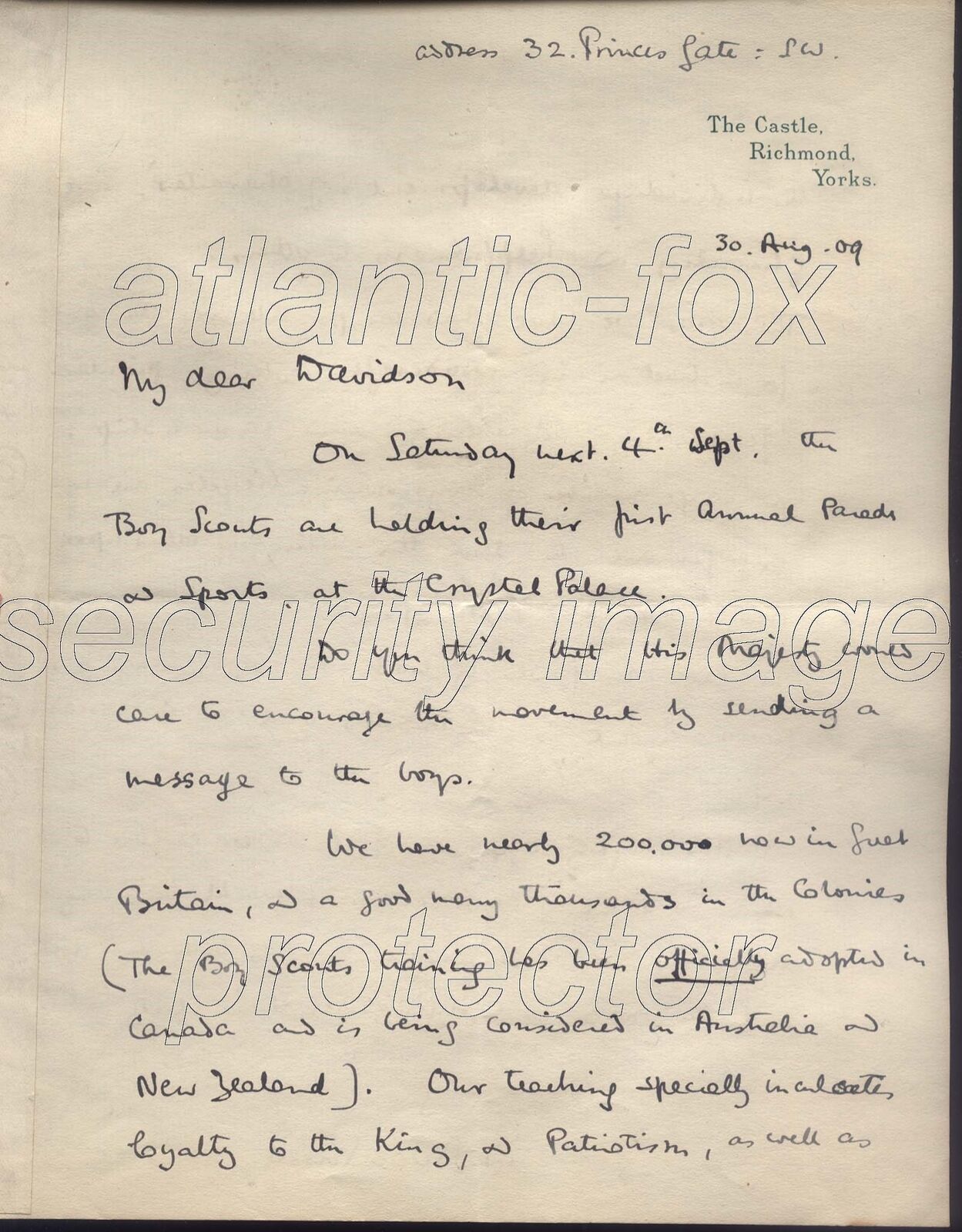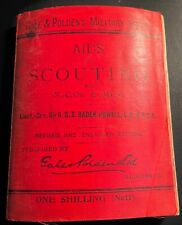1909 Baden Powell original letter to King Edward VII. A UNIQUE SCOUTING RARITY

When you click on links to various merchants on this site and make a purchase, this can result in this site earning a commission. Affiliate programs and affiliations include, but are not limited to, the eBay Partner Network.
1909 Baden Powell original letter to King Edward VII. A UNIQUE SCOUTING RARITY:
$4988.00
1909 Baden Powell original letter to King Edward VII. A UNIQUE SCOUTING RARITYThis product data sheet is originally written in English.
Asking the King for his support of the Scout Movement
1909; Amazing unique and Rare, original letter to King Edward VII, addressed to his Assistant Private Secretary, Arthur Davidson, asking for the Kings support of the Boy Scout movement,, the letter without doubt was probably read by "FRITZ" Frederick PONSONBY the Kings Private Secretary who gave the letter to his Brother Major General John Ponsonby for his Autograph Collection. the letter reads as follows.
"Address 32, Princes Gate; S.W.The Castle,Richmond, Yorks. 30. Aug .09My Dear Davidson,On Saturday next 4th Sept. the Boy Scouts are holding their first annual Parade & SPORTS, at the Crystal Palace.Do you think that His majesty could care to encourage the movement by sending a message to the boys.We have nearly 200,000 now in Great Britain, and a good many thousands in the Colonies (The Boy Scouts training has been officially adopted in Canada and is being considered in Australia and New Zealand). Our teaching specially inculcates loyalty to the King, & Patriotism, as well as the individual development of 'character', and chivalry and helpfulness to others.This year we have had camps all over the country for instruction in woodcraft, cooking, pioneering, lifesaving, signalling, and seamanship: and a large number of boys owning bicycles are under engagement to serve the King if called upon on any national emergency.We earn our funds by work and not by begging. The movement is 18 months old and is spreading rapidly.If His majesty approves of it and could care to send us a message of appreciation it would be a very great incentive and encouragement to both the officers and the boys in carrying out their duty to him.Yours very Truly,BadenPowell"
Colonel Sir Arthur Davidson, GCVO, KCB (12 November 1856 – 16 October 1922) was a British soldier and courtier. Davidson was born in Shooter's Hill, Kent, and grew up in Welwyn, Hertfordshire. He was educated at Henley Grammar School and Bute House School, Petersham. In September 1875 he was commissioned Sub-Lieutenant in the 4th Foot,[1] but a year later transferred to the 60th Rifles[2] and was posted to the 2nd Battalion in India. Soon afterwards he was promoted Lieutenant. He took part in the Second Afghan War in 1878–1880 and was appointed ADC to Lieutenant-General Sir Donald Stewart, and later to Major-General Ross. He served in the Boer War in 1881 and fought at the Battle of Tel-el-Kebir in 1882. In 1883 he was appointed Assistant Inspector of Army Signalling at Aldershot, a position he held until 1889,[3] with the temporary rank of Captain.[4] In 1885 he was promoted substantive Captain[5] and a month later promoted Brevet Major[6] in belated recognition of his services in Afghanistan five years earlier. He took part in the Bechuanaland Expedition of 1885.In 1890 Davidson was appointed ADC to Field Marshal The Duke of Cambridge.[7] He was promoted substantive Major in 1893[8] and Lieutenant-Colonel in 1895,[9] and on the duke's resignation as Commander-in-Chief later the same year entered the Royal Household as Groom in Waiting in Ordinary to The Queen.[10] He was promoted to Equerry in Ordinary in January 1896,[11] and continued to hold the position when Edward VII acceded to the throne in 1901. He was appointed Member of the Royal Victorian Order 4th Class (MVO) in 1896,[12] and Commander of the Royal Victorian Order (CVO) in 1901.[13] Appointment as Companion of the Order of the Bath (CB) came in the 1902 Coronation Honours list published on 26 June 1902,[14][15] and he was invested by King Edward VII at Buckingham Palace on 8 August 1902.[16] He was promoted Brevet Colonel in 1902[17] and retired from the Army later the same year.[18] He later became Assistant Keeper of the Privy Purse and Assistant Private Secretary to the King, while also remaining an Equerry. In 1906 he was appointed Knight Commander of the Royal Victorian Order (KCVO).[19] On Edward's death in 1910 he was appointed Knight Commander of the Order of the Bath (KCB) in the Accession Honours[20] and then appointed Extra Equerry to The King[21] and Equerry to Queen Alexandra,[22] holding both positions until his death at Sandringham. He was appointed Knight Grand Cross of the Royal Victorian Order (GCVO) in the 1921 Birthday Honours.1909 Crystal Palace Scout Rally From
Wikipedia, the free encyclopedia
The Crystal Palace Rally was an historic gathering of Boy Scouts and unofficial "Girl Scouts" at the Crystal Palace in London on Saturday, 4 September 1909.[1] The rally demonstrated the rapid popularization of Scouting with an estimated 11,000 boys attending with the prominent presence of Girl Scouts also being significant for the start of Girl Guides/Scouts.[2] The rally was held a year and a half after the publication of Scouting for Boys and The Scout magazine, and two years after Robert Baden-Powell's demonstration Brownsea Island Scout Camp. Some controversy occurred with attempts to exclude girls and Boy Scouts from the British Boy Scouts, Church Scout Patrols and other Scouts not registered with what would become the Boy Scouts Association, leading to challenges regarding the 4th Scout Law that "A Scout is ... a brother to every other Scout".The Rally was a precursor to the later Scout Jamborees and World Scout Jamborees.The concept of the Scouts' Own, a simple, non-denominational religious ceremony, was also introduced by H. Geoffrey Elwes at this rally.
Members of the local Scout Troop, 2nd Croydon (1st Crystal Palace Patrol), formed part of the Flag party for Princess Christian, the member of the Royal family in attendance. As a result, the Group, which is still in existence, has the right to call themselves Princess Christian's Own. The Group still meet near Crystal Palace Park and regularly use Crystal Palace park for Scouting activities
Powered by SixBit's eCommerce Solution1909; Amazing unique and Rare, original letter to King Edward VII, addressed to his Assistant Private Secretary, Arthur Davidson, asking for the Kings support of the Boy Scout movement,, the letter without doubt was probably read by "FRITZ" Frederick PONSONBY the Kings Private Secretary who gave the letter to his Brother Major General John Ponsonby for his Autograph Collection. the letter reads as follows. "Address 32, Princes Gate; S.W.The Castle,Richmond, Yorks. 30. Aug .09My Dear Davidson,On Saturday next 4th Sept. the Boy Scouts are holding their first annual Parade & SPORTS, at the Crystal Palace.Do you think that His majesty could care to encourage the movement by sending a message to the boys.We have nearly 200,000 now in Great Britain, and a good many thousands in the Colo EAN Does not apply Surname Initial P Period 1909 Famous Persons Baden Powell Theme Boy Scouts/ Scouting Autograph Type Manuscript Letter Type Historical
1909 Baden Powell original letter to King Edward VII. A UNIQUE SCOUTING RARITY:
$4988.00

Related Items:
1909 Baden Powell original letter to King Edward VII. A UNIQUE SCOUTING RARITY
$5019.40
1909 Baden Powell original letter to King Edward VII. A UNIQUE SCOUTING RARITY
$4988.00
Aids to Scouting, Baden-Powell, Second Edition (deeper content vs. 1st Ed.)
$1565.00






